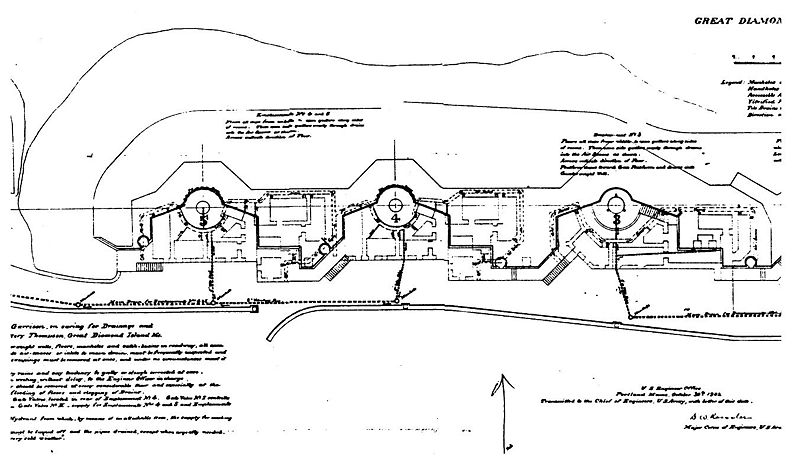Battery Acker
|
Battery Acker (1902-1943) - Battery Acker was a reinforced concrete, Endicott Period 6 inch coastal gun battery on Fort McKinley, Great Diamond Island, Cumberland County, Maine. The battery was named in G.O. 78, 25 May 1903, after Captain William H. Acker, 16th U.S. Infantry, who was killed 7 Apr 1862, at the Battle of Shiloh, Tennessee, during the U.S. Civil War. Battery construction started in 1899, was completed in 1902 and transferred to the Coast Artillery for use 11 Dec 1902 at a cost of $ 56,100.00. Deactivated in 1943.
Endicott Period (1890-1910)Part of the Harbor Defense of Portland, Maine. Originally built as an Endicott Period concrete coastal gun battery with two 6" M1897MI guns mounted on M1898 Disappearing carriages. This was a two story battery with the guns located on the upper level and the magazines below. Shells were moved from the magazine level to the gun loading platform by two Hodges back delivery hand operated hoists. No powder hoists were provided. Electrical power was furnished by the central power plant.

World War I (1917-1918)The U.S. entry into World War I resulted in a widespread removal of large caliber coastal defense gun tubes for service in Europe. Many of the gun and mortar tubes removed were sent to arsenals for modification and mounting on mobile carriages, both wheeled and railroad. Most of the removed gun tubes never made it to Europe and were either remounted or remained at the arsenals until needed elsewhere. The guns of Battery Acker were not affected by the World War I redistribution or the following 1920 disarmament program. The guns do appear to have been dismounted in 1917 as indicated in the 31 March 1919 RCW but they are shown remounted in the 20 May 1920 RCW. World War II (1941-1945)Battery Acker was obsolete at the beginning of World War II but remained a part of the Harbor Defenses of Portland plan until 15 Aug 1943 when it was ordered salvaged. The guns were transferred to Watervliet on 14 Oct 1943 and the carriages were ordered scrapped 15 Aug 1943. Current StatusMostly private property on Great Diamond Island, Cumberland County, Maine. No period guns or mounts in place.
Sources:
Links: Visited: 1 Jul 2012
| ||||||||||||||||||||||||||||||||||||||||||||||
